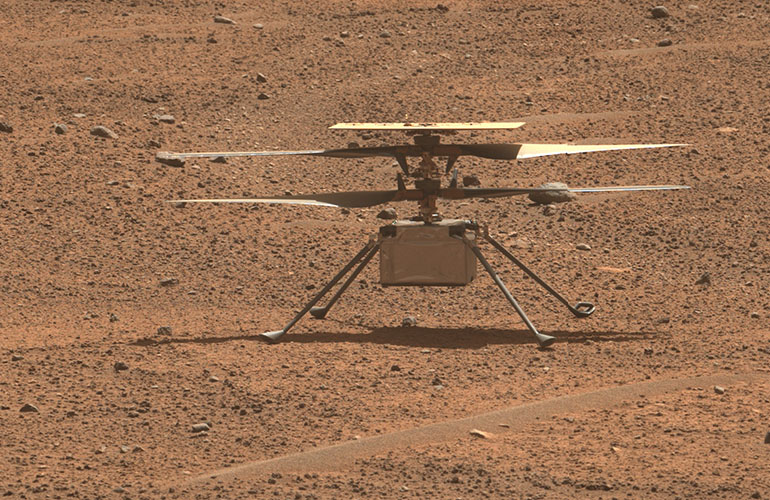|
Listen to this article  |

A photo of NASA’s Ingenuity helicopter taken by the Perseverance Rover on August 2. | Source: NASA/JPL-Caltech/ASU/MSSS
NASA’s Mars Ingenuity Helicopter has completed its first flight since its unscheduled landing during its July 22 flight. The most recent flight, Ingenuity’s 54th on the planet, was a 25-second up-and-down hop meant to give the Ingenuity team some insight on why the helicopter’s 53rd flight was cut short.
Flight 53, the one that Ingenuity had to end abruptly, was planned to be a 136-second scouting flight to collect images of the Martian surface for the Perseverance rover science team. The flight would include flight north for 666 feet (203 meters) at an altitude of 16 feet (5 meters) at 5.6 mph (2.5 meters per second), where it would hover and obtain imagery of a rocky outcrop.
After that, Ingenuity was supposed to go straight up 33 feet (10 meters) to allow its hazard divert system to initiate. It would then descend vertically to touch down.
In reality, Ingenuity was only able to fly north for 466 feet before its flight contingency program was triggered and the helicopter landed automatically after a total flight time of 74 seconds.
“Since the very first flight we have included a program called ‘LAND_NOW’ that was designed to put the helicopter on the surface as soon as possible if any one of a few dozen off-nominal scenarios was encountered,” said Teddy Tzanetos, team lead emeritus for Ingenuity at NASA’s Jet Propulsion Laboratory in Southern California. “During Flight 53, we encountered one of these, and the helicopter worked as planned and executed an immediate landing.”
The Ingenuity team believes that this early landing was triggered by image frames from the helicopter’s navigation camera not syncing up correctly with data from Ingenuity’s inertial measurement unit, which measures its acceleration and rotational rates.
Data from the inertial measurement unit allows NASA to estimate where the helicopter is, how fast it’s moving, and how it’s oriented in space.
This same problem happened at the beginning of Ingenuity’s life on Mars on its 6th flight on May 22, 2021. Ingenuity experienced excessive pitching and rolling during the flight because multiple image frames had been dropped.
After this incident, the Ingenuity team updated the helicopter’s flight software to help mitigate the impact of dropped images, which worked, up until Flight 53. During that flight, the number of dropped navigation images exceed what the earlier software patch allowed.
“While we hoped to never trigger a LAND_NOW, this flight is a valuable case study that will benefit future aircraft operating on other worlds,” said Tzanetos. “The team is working to better understand what occurred in Flight 53, and with Flight 54’s success we’re confident that our baby is ready to keep soaring ahead on Mars.”
Ingenuity touched down on Mars in April 2021. The helicopter was the first ever helicopter to be sent to another planet. It was sent as a technology demonstration to test the first powered flight on Mars. While the helicopter has been flying strong for over two years now, NASA’s team doesn’t expect it to last forever.
NASA has been so encouraged by Ingenuity’s success that it decided to swap out its Sample Fetch Rovers for two drones, similar to the helicopter, to serve as backups to the Perseverance Rover in the Mars Sample Return Campaign.
Credit: Source link


Comments are closed.